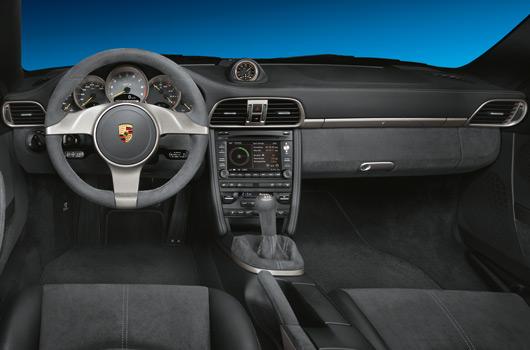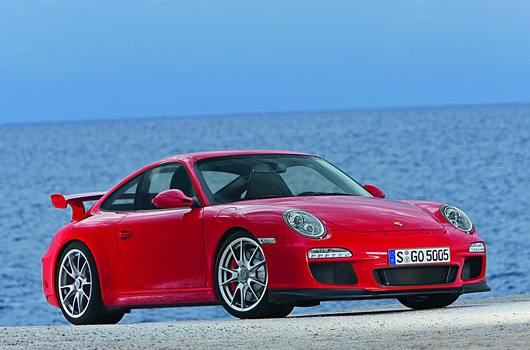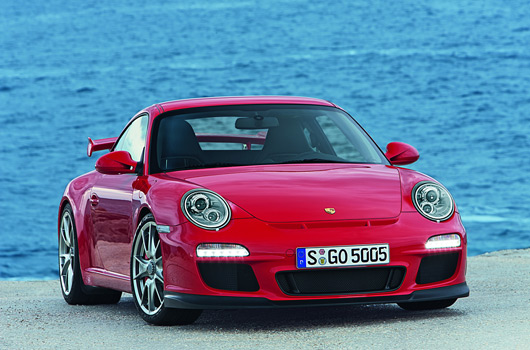The next release of the Porsche 911 GT3 will officially take place at the Geneva Motor Show on 3 March. European sales will commence in May.
If, like me, you’re unable to make the Geneva shindig, you’ll just have to make do with looking at the pretty pictures and reading the nice words Porsche have put together for us all.
Porsche, as ever, have kept the improvements under the skin. Of course, there are a few external tweaks, but not enough that anyone would really care, or notice immediately. Unlike its mad RSR brother, there’s no wild guards or cut out bonnets.
What this new 911 GT3 has, though, is more. More engine. More power. More grip. More speed. And, more gadgets. In this context Mies van der Rohe got it wrong, we like more. More is good.
Powered by a newly developed 3.8 litre flat six, the GT3 produces 320kW (435bhp), 15kW more than its predecessor. It will go from 0-100km/h in a wee 4.1 seconds, reaching 160km/h in a mere 8.2 seconds before reaching a v-max of 312km/h.
The white lab coats have also had a play with the electronic aids, and the stability and traction control systems can be switched off independently. According the press guff this gives “the driver unrestricted, individual control over the driving dynamics of his car”. Sabine Schmitz need not apply, it seems.
The lab coats didn’t stop there, either, as they found the time to add an optional lift system for the front axle, which can give sir 30mm more ground clearance at the touch of a button.
I want one!
UPDATE: Video footage of Walter Röhrl driving the GT3 can now be seen at AUSringers.com
New Porsche 911 GT3: Top Performer on the Road with Ambitions on the Track
Stuttgart: Dr. Ing. h.c. F. Porsche AG, Stuttgart, is adding yet another new model to the second generation of the 911 model series: the new GT3 even more powerful, faster, and refined than its predecessor.
In developing the most sporting and dynamic road-going 911 with a normal-aspiration power unit, Porsche has applied a wide range of know-how gained in motorsport. Indeed, this is precisely why the new GT3 is truly impressive not only on the road, but also on the race track.
The new 911 GT3 is making its world debut at the Geneva Motor Show on 3 March, with Europe-wide sales starting in May.
The 911 GT3 offers an even higher standard above all in two key areas: performance and driving dynamics. Now the proven six-cylinder naturally-aspirated power unit develops maximum output of 435 bhp (320 kW), up 20 bhp over its predecessor. This results first and foremost from an increase in engine capacity by 200 cc to 3.8 litres and from the improved gas cycle: now not only the intake, but for the first time also the exhaust camshafts are adjusted by VarioCam.
A further important point is that, through its upgraded power and performance, the boxer engine also offers a significant increase in torque at medium engine speeds, a benefit of particular significance in everyday motoring. Clearly, this also means a further improvement in performance, the new GT3 accelerating from a standstill to 100 km/h in 4.1 seconds and reaching 160 km/h in 8.2 seconds. Top speed is 312 km/h or 194 mph.
The second highlight in developing the 911 GT3 to an even higher standard was to further improve the car’s driving dynamics: For the first time the 911 GT3 comes with a particularly sporting variant of PSM Porsche Stability Management, offering the option to deactivate both Stability Control (SC) and Traction Control (TC) in separate steps. And to give the driver unrestricted, individual control over the driving dynamics of his car, these functions are not reactivated automatically even under the most extreme driving conditions, but only at the touch of a button.
The new GT3 offers even better grip and stability also at high speeds, specific modifications of the car’s aerodynamics increasing down-forces both front and rear to such an extent that the overall pressure pushing down the car is more than twice as great as on the former model. At the same time the new Aerodynamics Package gives the GT3 a brand-new look further accentuated by the new bi-xenon headlights, LED rear light clusters, as well as modified air intakes and outlets.
The active PASM suspension of the 911 GT3 enables Porsche’s engineers to make the springs and anti-rollbars somewhat stiffer yet again, thus ensuring even more precise handling in the PASM sports mode, while retaining appropriate roll comfort suitable for everyday use in the normal PASM mode. New, even lighter wheels in racing design with central locking and UHP (ultra-high performance) tyres now even featuring tyre pressure control round off the functional and visual enhancement of the GT3.
With driving dynamics and performance increasing to an even higher level, the brake system, following an old Porsche tradition, has been enhanced accordingly on the new 911 GT3. The brake discs now come with an even larger friction disc and an aluminium cover to reduce weight even further. Further improvement of brake ventilation, in turn, guarantees an even higher level of consistent brake power also over long periods. And as an option the GT3 comes as before with an exclusive version of PCCB ceramic brakes made specifically for this model.
Starting in autumn, the new GT3 will be available with yet another option making the car even more suitable for the race track: new and highly innovative PADM (Porsche Active Drivetrain Mount) engine bearings. These special engine mounts recognise a particularly sporting, race-like style of driving, making the normally elastic engine suspension hard and particularly resistant. This retains all the motoring comfort of the GT3 in everyday traffic, while on the race track the car is not affected by any mass forces coming from the engine, as would otherwise be the case in fast bends and on winding tracks.
Yet a further advantage is the car’s improved traction when accelerating from a standstill.
Another feature also new on the new model is the optional lift system for the front axle able to raise the ground clearance of the car for driving on bumpy surfaces or steep gradients – for example into an underground garage – at the touch of a button by 30 millimetres or almost 1.2â€.
The Euro base price of the new GT3 is Euro 98,100, in Germany the retail price including value-added tax and specific national features is Euro 116,947. In the USA the GT3 will be at the dealership in October at a price of USD 112,200 (MSRP without taxes).
The Porsche UK press release is the same, but different. They have used a few more acronyms…
Top performer on the road with ambitions on the track – new Porsche 911 GT3 to debut in Geneva
The new Porsche 911 GT3, which will make its world debut at the Geneva Motor Show on March 3 2009, is the latest evolution of an iconic sports car. Embodying the essence of more than 23,000 Porsche racing victories, the 911 GT3 is the ultimate integration of driver and car and arrives in the UK this autumn.
In developing the second generation of the Type 997 911 GT3 into the most sporting and dynamic road-going 911 ever with a naturally-aspirated power unit, Porsche has applied a wide range of know-how gained in motor sport. Indeed, this is precisely why the new GT3 is truly impressive not only on the road, but also on the race track.
The 911 GT3 offers an even higher standard above all in two key areas: performance and driving dynamics. The proven six-cylinder naturally aspirated power unit now develops a maximum output of 435 hp (320 kW), up 20 hp over its predecessor. This results first and foremost from an increase in engine capacity by 200 cc to 3.8-litres and from improved cylinder head gas flow: now not only the intake, but for the first time also the exhaust camshafts, are adjusted by VarioCam.
A further important point is that, through its upgraded power and performance, the flat six ‘boxer’ engine also offers a significant increase in torque at medium engine speeds, a benefit of particular significance in everyday motoring. Clearly, this also means a further improvement in performance; the new GT3 accelerates from a standstill to 62 mph (100 km/h) in 4.1 seconds and reaches 99 mph (160 km/h) in 8.2 seconds. Top speed is 194 mph.
The second emphasis in developing the 911 GT3 to an even higher standard was to further improve the car’s driving dynamics. For the first time, the 911 GT3 comes with a particularly sporting variant of Porsche Stability Management (PSM), offering the facility to deactivate both Stability Control (SC) and Traction Control (TC) in separate steps. And to give the driver unrestricted, individual control over the driving dynamics of his car, these functions are not reactivated automatically even under the most extreme driving conditions, but only at the touch of a button.
The new GT3 offers increased grip and stability at high speeds, courtesy of specific modifications to the car’s aerodynamics which have increased downforce front and rear to such an extent that the overall air pressure pushing down on the car is more than twice as great as on the former model. At the same time, the new ‘Aerodynamics Package’ gives the GT3 a distinctive appearance which is further accentuated by new Bi-Xenon headlights, LED rear light clusters, and modified air intakes and outlets.
The Porsche Active Suspension Management (PASM) fitted to the 911 GT3 has enabled Porsche engineers to make the springs and anti-roll bars stiffer yet again, thus ensuring even more precise handling in the PASM ‘sports’ mode. However, the PASM ensures appropriate ride comfort suitable for everyday use when in the ‘normal’ PASM mode. The GT3 rides on new, lighter wheels in a racing-inspired design – with a centre locking nut – fitted with ultra-high performance (UHP) tyres. Tyre pressure monitoring is fitted as standard.
With driving dynamics and performance increasing to an even higher level, following Porsche tradition the braking system has also been enhanced accordingly on the new 911 GT3. The brakes now feature larger friction discs and an aluminium cover to reduce un-sprung weight further still. Brake ventilation has been improved, which guarantees a higher level of consistent stopping power over long periods. As an option, the GT3 comes as before with an exclusive version of the Porsche Ceramic Composite Brakes (PCCB) made specifically for this model.
Making the car even more suitable for the race track, the new 911 GT3 will be available with the option of new and highly innovative Porsche Active Drivetrain Mount (PADM) engine mountings. These special engine mounts recognise a particularly sporting, race-like style of driving, making the normally ‘elastic’ engine mounts harder and particularly resistant. This retains all the motoring comfort of the GT3 in everyday traffic, while on the race track the effect of the mass forces coming from the engine is much reduced, particularly in fast bends and on winding tracks. Yet a further advantage is improved traction when accelerating from a standstill.
Another new feature is the optional lift system for the front axle which is able to increase the ground clearance of the car, at the touch of a button, for driving on bumpy surfaces or steep gradients – for example into an underground garage – by 30 millimetres (approx 1.2 inches).
The new Porsche 911 GT3 goes on sale in the United Kingdom and Ireland from autumn 2009, priced from £81,914. Further specifications and technical details will be confirmed nearer to launch.
Fitted to every 911 GT3 is a Porsche Vehicle Tracking System (VTS), a sophisticated vehicle security package approved to Thatcham Category 5 standard, and customers will also be able to explore the potential of their new car by participating in a complimentary course at the new Porsche Driving Experience Centre, Silverstone.







16 replies on “2010 Porsche 911 GT3”
‘s alrigh’, init?
But WOW, never realised you interviewed Sabine!! Could she possibly be more awesome? [/fanboy] Massive props for that one.
Cheers, that was one of the first stories posted on AUSringers. A year ago tomorrow. 8)
[…] manufacturers revealing new models in Geneva, including Aston Martin, Audi, BMW, Mazda, Renault and Porsche. There is also some speculation that a new hot Golf R20T could be […]
[…] at least, the new Porsche 911 GT3 still can’t match the Nissan GT-R in a hot lap around the Nürburgring Nordschleife. […]
[…] January, before the Geneva Motor Show, Porsche gave us the new 911 GT3. Now, before the Franfurt Motor Show, they are giving us the GT3 […]
[…] chance to indulge in a day behind the wheel of a current model Porsche 911 GT3 on an unrestricted racetrack is surely one that most driving enthusiasts would jump at with great […]
[…] legend Walter Röhrl loves his new Porsche 911 GT3 so much he made this little video of himself with his car. He took his beloved GT3 to the Autodromo […]
[…] the model name Porsche 911 GT3 to any car person and chances are they’ll start to go weak at the knees. Add two more letters […]
[…] part even if they’ve knocked off the wheels from an Audi R8 V10 and looked at one too many Porsche 911s when mocking up those LEDs in the lower […]
[…] the 911 GT3 really able to turn Clarkson’s opinion around 180 degrees? Follow the link below to find […]
[…] 4.0 litre motor with 480hp (45hp more than 3.8 litre in current GT3). […]
[…] The new Porsche 911 Carrera S has reportedly posted a best lap time around the Nordschleife of 7 minutes 40 seconds. That makes the 991 model 13 seconds quicker than the 997 it replaces. It also means the new 911 Carrera S, with a 294kW 3.6 litre flat six, is as fast as the 997 911 GT3. […]
[…] 997 GT3 will remain in our top 5 most wanted list for many years yet, so it is with great anticipation we […]
[…] the 991 GT3 will be offered with one transmission option only, just like the near-perfect 997 model. However, whereas the old model was 6-speed manual only we know the new model will have seven […]
[…] while back I arranged with a mate in Melbourne to test his 997 Porsche 911 GT3 for AUSmotive. Then, a couple of weeks before I arrived he did something stupid and traded it in. […]
[…] The clips are a few years old now and were published by Motor Trend. Our best guess is they were produced at a media launch for the, then new, 997 911 GT3. […]